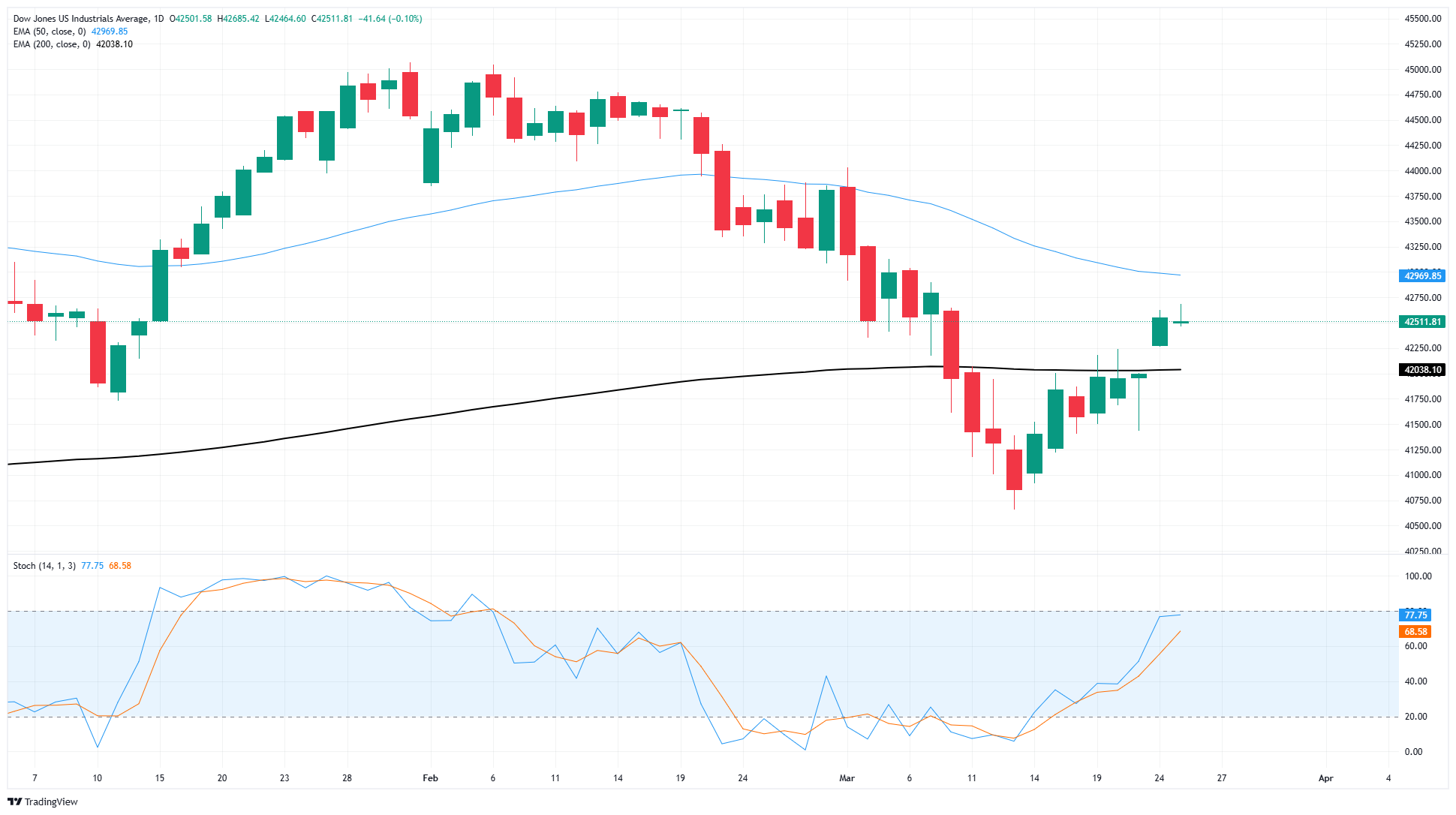- Dow Jones is still stuck near 42,500 on Tuesday.
- The shares fell after another sharp shrinkage in CEB expectations.
- Investors remain cautious against slowing economic data and the potential rise in inflation.
Dow Jones Industrial Malce (DJIA) stuck to its place on Tuesday, where he applied it near the level of 42500 after another sharp decrease in the results of the Consumer confidence survey to the upscale recovery in the short term in stock prices. Smooth polls continue to reduce due to uncertainty in politics and uncertainty in customs tariffs, while preserving the innate appetite for risks, as investors wait for signs or stability in both economic conditions and American commercial policy.
According to the US Conference Council (CB), consumer enlargement expectations increased for a year again, increasing to 6.2 % in March compared to 5.8 % of February. According to CB, consumers are still concerned with an overwhelming majority of the high price of basic home commodities such as eggs, and comprehensive concerns about the implications of potential inflation from the Trump administration tariff. CEA’s Consumer confidence survey of future economic expectations has also decreased to the lowest new level for 12 years in March, as it decreased to 65.2 and retracted the 80.0 mark that usually predicts a possible stagnation.
In addition to an insult to the injury, the MOODY’S TransIng Classification Agency issued a famous warning on Tuesday early that the US financial force had “deteriorated”, which in particular highlighted the inability to serve US debt. After moving forward, MOODY indicated that the US financial strength is heading to a multi -year decrease, a statement that Donald Trump is likely to be angry and managed, who actively pursue a minimum debt from Congress.
Stock news
Despite a set of warning data and observations on Tuesday, the morale of the investor is still relatively stable heading to the middle of the trading week. Dow Jones is still stuck in a 42,500 area, and the Standard & Poor’s 500 (S&P) was also flat, as the water was stepping near 5760. The nasdaq index rose about a quarter of one percent to 18230, as technical stocks regained their foot, but not enough to withdraw the rest of the stock market.
Read more stock news: Apple shares rise with NVIDIA weight
Dow Jones price expectations
Dow Jones Industrial Value has run out of gas in the short term, holding bids inside the day at a level of 42,500. The basic procedure still tends to buy buyers after DJIA recovered to the upper side of the 200 -day SIA moving average (EMA) near the 42000 main price handle, but the offers may be ready to rest.
Technical oscillator shows that the bulls still have an operating room, but their climbing is sharp to restore standard levels north of 45,000. Ultimately, the rear decline can mean an extensive decrease below the latest oscillation to 40,660.
Dow Jones scheme for 5 minutes
Dow Jones Daily Plan
S & P 500 common questions
The S&P 500 is a widely followed stock price index, which measures the performance of 500 companies owned by the public, and is seen as a wide measure of the US Securities Market. The effect of each company is weighed on the expense of the index on the basis of market value. This is calculated by hitting the number of shares traded in the company according to the share price. The S&P 500 has achieved impressive returns – $ 1.00 was invested in 1970 a return on $ 192.00 in 2022. The average annual return since its inception was in 1957 11.9 %.
Companies are chosen by the committee, unlike some other indexes that are included based on specific rules. However, they must fulfill some eligibility standards, the most important of which are the market value, which must be greater or equal to $ 12.7 billion. Other criteria include liquidity, homeland, general float, sector, financial ability, long -term period of time, and the representation of industries in the United States economy. The largest nine companies in the index account for 27.8 % of the market value of the index.
There are a number of ways to exchange the S&P 500. Most of the retail brokers and the betting platforms scattered for merchants are allowed to use contracts for teams (CFD) to put bets in the direction of the price. In addition, this can buy in mutual and mutual funds (ETF) that follows the price of the S&P 500. Most of the traded investment boxes are the state street Corporation. Chicago Mercantile Exchange (CME) offers future contracts in the index and the CMOE options board offers options as well as in circulation investment funds, traded investment funds, and traded investment funds.
Many different factors pay the S&P 500, but mainly it is the total performance of the component companies that have been revealed in the company’s quarterly and annual profit reports. The total economy data, the United States and the United States also contribute because it affects investor morale, which if they are positive gains. The level of interest rates, set by the Federal Reserve (Fed), also affects the S&P 500 because it affects the cost of credit, on which many companies depend significantly. Therefore, inflation can be a major driver as well as other standards that affect the decisions of the Federal Reserve.
adxpro.online
